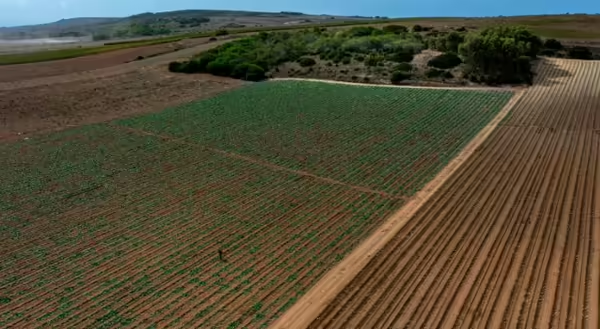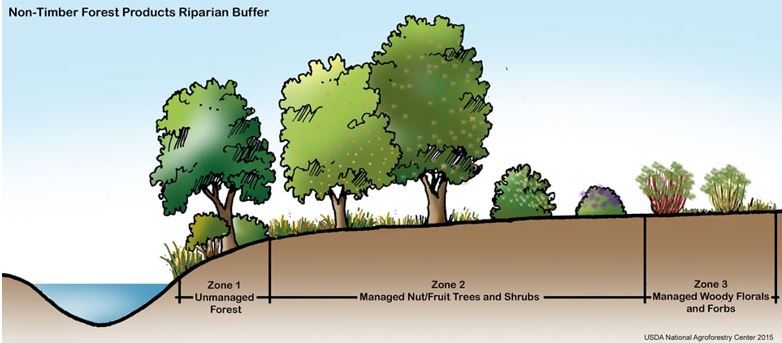
Edge-of-field practices are often lumped under the regenerative agriculture umbrella, but these practices tend to have different goals than those typically associated with regenerative systems. Most regenerative agricultural practices focus on building and maintaining soils, with enhancing biodiversity as a secondary focus. Edge-of-field practices on the other hand often do little to improve soil health but offer huge benefits to enhancing biodiversity and improving water quality. In this article, we’ll cover some common edge-of-field practices and their benefits.
What are edge-of-field practices?
As the name implies, edge-of-field practices are those that are implemented on the edge of farmland, such as along ditches and fencerows. In-field practices are what we typically think of when discussing regenerative agriculture. These are techniques that are implemented within a field, like covering crops and reduced tillage. Edge-of-field practices are some of the least utilized by farmers but could be an effective strategy for controlling nutrient runoff, increasing biodiversity in agroecosystems, and improving the resiliency of farms. Edge-of-field practices are designed to slow, filter, and process both surface and subsurface runoff from fields. They capture excess nutrients—like nitrogen and phosphorus—and sediment from fields to prevent them from entering streams and rivers. Edge-of-field practices are an essential part of the solution to addressing the goals of the Illinois Nutrient Loss Reduction Strategy.
What are some examples of edge-of-field practices?
Bioreactors
Bioreactors are trenches buried at the edges of fields that are typically filled with wood chips. Water from the existing tile drainage flows through the bioreactor before draining into another water source. The woodchips in the bioreactor act as a substrate for denitrifying bacteria—aka bacteria that break down nitrate found in water into atmospheric nitrogen. This process removes nitrate from the tile water, which is instead released into the atmosphere as nitrogen gas, preventing those nutrients from entering waterways. Bioreactors are fairly simple to install, require little maintenance, and do not require additional land to be taken out of production.
Constructed wetlands
Constructed wetlands are engineered wetlands that are designed to mimic those found in nature. The essential part of wetlands is the plants—which absorb excess nutrients and act as carbon sinks. Wetlands can be used to filter the water from a tile-drained system. A recent study conducted by The Nature Conservancy at a farm in Lexington, IL found a 50% reduction in nitrogen entering waterways using only a relatively small wetland. Some additional benefits of wetlands are that they act as a sponge to soak up excess water during times of heavy rainfall and provide habitat for wildlife.
Prairie strips
Prairie strips are an edge-of-field technique that strategically places strips of native prairie plants throughout a field to improve water quality and provide wildlife habitat. Prairie strips can be implemented on the edges of fields and along fencerows in land that is not currently in production, but they can also be added to low-yielding areas. Not all ground yields the same and some low-lying areas can collect water that prevents crops from producing as well as other more well-drained areas. Converting these acres to native prairie can provide benefits to wildlife and pollinators, while also reducing input costs on the same land. A farmer in McDonough County even noticed that adding prairie strips to the land he farms brought quail back to the area by providing habitat and food for the birds.
Vegetated riparian buffers
A riparian buffer is a strip of vegetation adjacent to a body of water that contains a combination of trees, shrubs, and other plants. Its main purpose is to prevent stream bank erosion and nutrient runoff. Like prairie strips and constructed wetlands, they act as a filter for water that is exiting farmland and entering waterways. They also protect farmland from flooding by absorbing some of the excess water before it reaches fields.
When considering adding an edge-of-field practice to a farm, growers should first consider the areas on their property where they need to stop erosion or control excess water. Low-lying, poorly drained areas are already not yielding well, and it may be more cost-effective to take these areas out of production. Areas along drainage ditches at the edge of fields are particularly well suited for the implementation of an edge-of-field practice. There may already be an existing buffer strip in these areas that could be enlarged to help control soil erosion and nutrient runoff.
Edge-of-field practices can seem daunting to implement but are something that growers should keep in mind when considering adding regenerative practices to their operations. Edge-of-field practices are the icing on the cake in a regenerative system and improve the sustainability of our agricultural system.
More information about edge-of-field practices can be found in Leading at the Edge: A Roadmap to Advance Edge-of-Field Practices in Agriculture
Emily Hansen is a Commercial Agriculture Educator with University of Illinois Extension, serving Bureau, LaSalle, Marshall, and Putnam counties. Emily provides research-based educational programs that empower growers to make sustainable choices on their farms.
DeLong, C., Lindahl, C., & Johnson, K. (2021). Leading at the edge: A roadmap to advance edge of field practices in agriculture. Journal of Soil and Water Conservation, 76(2), 41A-43A.
Mitchell, M. E., Newcomer-Johnson, T., Christensen, J., Crumpton, W., Dyson, B., Canfield, T. J., ... & Forshay, K. J. (2023). A review of ecosystem services from edge-of-field practices in tile-drained agricultural systems in the United States Corn Belt Region. Journal of Environmental Management, 348, 119220.



